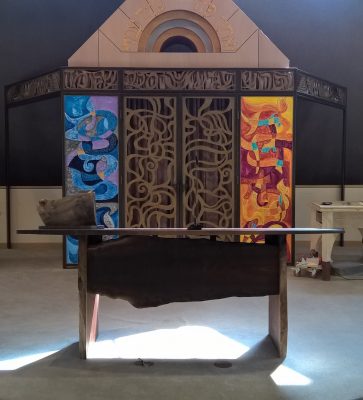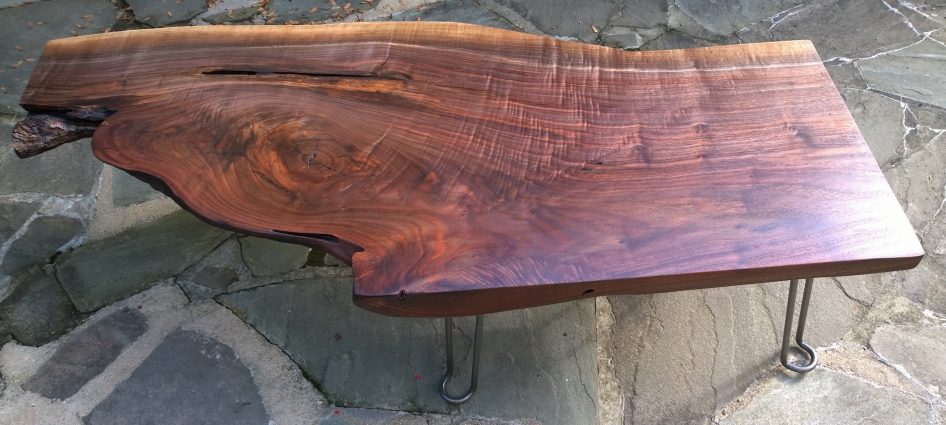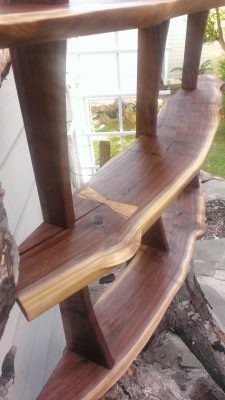This article appeared in The Town Courier.
His wife, Cara, calls him the tree whisperer. For years, he has rescued downed trees, one as wide as seven feet in diameter, from the mulch machine. Then back in his Kentlands workshop he patiently coaxes out their inner beauty. By turning these old trees into something new, Shaun O’Connor hopes they will live on for many generations to come.
His live edge furniture is as beautiful as it is unexpected.

When working onsite with his chainsaw and portable mill to slab the wood, O’Connor said he’s always thinking about what this particular wood wants to be, “what’s the right thing, and where are the best places within the tree.”
Then back in his workshop, he marvels in uncovering the colors and grains of the wood, and loves working with the natural or live edges of the wood to design tables that beg to be touched and shelves that engage the imagination.
But most importantly for this career technologist and lifelong woodworker, creating furniture from found wood is just fun.
At the moment, he said that he has a bit of the end-of-project blues. His reading table will be leaving his workshop the next morning to be installed in the sanctuary at his synagogue, Temple Beth Ami in Rockville, just in time for the High Holy Days. “Currently, they have one relatively small table that’s just for the Torah and a couple of podiums, and the rabbi wanted to bring everything together from a unified point of view—the cantor and another rabbi and whoever else happens to be there—so that’s what this is about.”
Massive in size and adorned with a tabletop music stand for the cantor made from a different piece of the same wood, the reading table is a black walnut that grew in Chevy Chase for about 150 years. “It was a gorgeous, big beautiful tree that during the derecho in 2012, it snapped half of the tree off and landed in the house,” O’Connor recalled. “The house was not condemned but it could not be occupied for quite a while. Amazingly, the woman (who owned the house) recognized that this tree had value and she should find somebody to take it, so she put it up on a woodworking bulletin board. A friend of mine saw it, called me because he knew that I was into milling wood, and I’ll tell you what, it just was an absolute find.”

O’Connor brought his chainsaw and portable mill, and slabbed the black walnut right on the property. The wood has been drying since 2012.
Black walnut, O’Connor said, is one of his favorites. “It’s a nice hard wood but it’s pretty forgiving—in other words, it works really well. … It’s a very hard wood and it’s a very long-lasting wood for sure, but when you sand it and when you bring it down to this kind of level, the figuring and just the striations and the different look and feel of the wood just absolutely pops out—that’s what I love about black walnut.”
He pointed out the variations in color and grain found in the wood. “I mean if you love grain, check out this then. It’s amazing, it’s just amazing.” When working with the wood, “you can sort of guess that, ooh, that could be nice—or not guess at all and then suddenly it exposes this treasure. It’s just wonderful.
“When I first cut this and removed the bark off this walnut … it was ivory white,” he added. “It was absolutely white on the outside and black as black on the inside. It was unbelievable.”
The lighter, outer portion of the tree, he explained, is sap wood, and the interior, darker wood of the black walnut is called heart wood. Working with the different woods and grains to create a beautiful piece of furniture is “really a fun thing to do,” he said. “These things are just so one-of-a-kind, totally unique.”

O’Connor credits a colleague and friend at Microsoft for turning him onto live edge furniture, “specifically George Nakashima and his work. … It was like, ‘Oh, my God,’ it was really an epiphany that came over.”
His love for woodworking, though, goes back to his earliest days when at the age of six he began helping his uncle in the workshop. He still uses some of his uncle’s equipment. The ban saw “is the first saw that I learned how to use with my uncle. It’s 1930s-era equipment, and It works great.” The table saw has become his workhorse, O’Connor said, and “when I was six, my job was to open up the little door handle underneath there and suck out all the dust.”
O’Connor said that he continued to learn about carpentry, handiwork and woodworking of all sorts as he was growing up, and then he bought a house that was being built. He spent 30 years as a career technologist, working for Microsoft and Siemens Communications, but continued woodworking during his off hours.
He even spent one two-week summer vacation milling a willow oak that grew at the corner of 17th Street and Constitution Avenue, NW on the Organization of American States property. The willow oak lost a big branch in a heavy windstorm, “and I ended up getting the first 32 feet of that tree which is at the base around 7 feet in diameter, just gigantic.” He cut all of it up himself, but needed a friend to haul the slabs away with a crane and store them at his tree service, Nelson Tree Specialist in Prince George’s County.
Recently, O’Connor said he “had the opportunity to jump out (of his career field) and start doing this stuff in a more concentrated and expansive way. It’s been great.”
He dreams of working with the willow oak when it is dry enough, and knows that it will be beautiful. Wood needs to dry one year per inch “to stabilize it and get most of the moisture out.” In the meantime, O’Connor has lots of wood stored in his workshop and beneath a tarp in his side yard that is ready to be worked.
And then there’s the stump on his back patio. “I brought that home several years ago and thought, wow, this could be a real cool base to a table or it could be … a tremendous set of cutting boards, or I could just stand it up on end and sit on it and it could be a bench,” O’Connor mused. Right now, though, he said that it intrigues his 4-year-old neighbor.
It’s safe to say that the stump also intrigues the tree whisperer who will someday know what it wants to be.
To see more of Shaun O’Connor’s work, visit www.custommade.com/by/shaun-oconnor or contact him at shaun.oconnor@live.com.